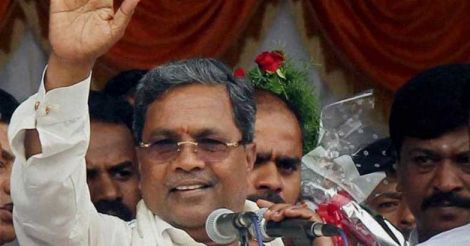With assembly elections pitched less than a year away, the southern state of Karnataka is already starting to feel the heat of the confusing multicultural narrative of regionalism and diversity. The recent demands for a state flag and the increasing anti-Hindi violence that targeted different public installations in the city point towards this.
Screeching voices, including that of incumbent chief minister Siddharamaiah, have come up demanding a state flag, something that the Indian federal structure doesn't explicitly support or reject. Currently, only the state of Jammu and Kashmir, with its special status under article 370, has the constitutional sanction to have a separate flag.
Incumbent chief minister Siddharamaiah has come out in defense of his government and people, asking if there is a constitutional provision that barred the states from having their own flags. The Congress leader dared the BJP to say there was no need for a flag for Kannadigas.
His government has also constituted a nine-member committee to look into the issue and submit a report on designing a separate flag for the state and providing a legal standing for it, an official said on Thursday.
The Kannadigas had been proudly spotting their vermilion and yellow flag ever since the predecessor of the current one was designed by Ma Ramanathan, a Bengaluru based social activist and journalist, in 1964 as a response to regionalist sentiments.
The current flag, apparently symbolizing the propitious turmeric and vermilion, has borne a pride of place in the cultural landscape of Karnataka and can be found widely in use during state festivals like the Karnataka Rajyotsava on November 1.
This flag that actively populates the cultural passions of the Kannada people also finds its place on the official website of the government of Karnataka. Union home ministry officials have said that while Kannadigas are free to have their own flag, the government of Karnataka cannot have one, being a part of the federal structure.
With this, the Centre has reiterated the long-standing dictum that the nation is a single unit and the cultural differences will be subsumed under a common national flag.
Close on the heels of the demand for a new flag, the Karnataka Rakshana Vedike (KRV) has come out blackening the Hindi signboards at different Bangalore metro stations.
The vandalism that played out saw the Namma Metro stations, that the attackers claimed were a state project, being surrounded by the KRV cadre who shouted slogans and held placards demanding the removal of Hindi. The attackers claimed that the Bangalore metro authorities had failed to remove the Hindi boards within the 'deadline' given to them.
The KRV, with its history of extreme regionalist propaganda and a wholly Kannada website, had earlier been involved in protests that rocked the states and created sporadic incidents of violence on several occasions.
While some of this included geographical claims like Belgaum, some others were linguistic, like the one against English on signboards and the anti-Hindi conference in 2006. Now the same organization has risen against the Hindi signboards in the metro stations, with their cadre unleashing wanton destruction across the city.
According to the police, the Hindi name boards of five metro stations, viz., Yeshwantpur, Peenya, Deepanjali Nagar, Jayanagar and Mysore Road, have been blackened by KRV activists late Wednesday night. Following this, security has been beefed up in the 42 different metro stations in Bengaluru.
Meanwhile, Arun Javagal, who heads the IT wing of the KRV, said that the vandalism was their "last resort." According to him, the KRV's Narayana Gowda had been urging the Bangalore Metro Rail Corporation Limited (BMRCL) to ensure Hindi was kept out of the Namma Metro sign boards, which had been following the trilingual policy. He said that despite five years of persuasion, the changes have not reflected, leaving the KRV with no other alternative but the “last resort.”
The KRV had also been banking upon the responses to their anti-Hindi twitter campaign, #NammaMetroHindiBeda (Our Metro, we don't want Hindi), to push for their demands to remove Hindi.
The Kannada Development Authority had reportedly issued a notice to the BMRCL on July 4 at the behest of chief minister Siddaramaiah, demanding an explanation on its continuing three-language policy. On July 3, the cadre had defaced the English signboards at Chickpete and Majestic stations, taping over them.
Siddharamaiah is perhaps unleashing a fresh demon to counter the saffron outfit, which is keen to wrest power in the only major Congress-ruled state. A hardline regional card would be difficult for the BJP to counter as it has always banked on exploiting chauvinistic sentiment. It cannot also afford to mount a counter-offensive against the anti-Hindi tirade, lest it would be perceived as a party, which has its moorings predominantly in the Hindi belt.
In case it dares to take such a stance, it would be easy prey for Siddharamaiah and Congress, by dubbing it as an “anti-Kannadiga, pro-Hindi outfit working against the interests of the state.”
Siddharamaiah is stoking flames that may engulf the social fabric of Karnataka with the sole aim of retaining power, but the BJP could come up with counter fixes that can only be worse. Either way, colossal losses would be for the Mannina Maga or son of the soil.

























 Karnataka Chief Minister Siddaramaiah
Karnataka Chief Minister Siddaramaiah